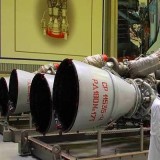Exclusive: US Lockheed Martin F-35 Fighter Jet Controls Drone in Flight Using AI Technologies

{loadposition bannertop}
{loadposition sidebarpub}
2024 – Lockheed Martin is revolutionizing the future of air combat warfare by pushing the boundaries of how fighter aircraft and autonomous systems operate together in high-stakes, contested environments. On January 22, 2025, the company released a major update detailing its innovations throughout 2024, showcasing its efforts to enable U.S.-made fighter jets, such as the F-35, to control drones. This effort is central to the U.S. Air Force’s ambitious development of the Collaborative Combat Aircraft (CCA) fleet, a key element of the Air Force’s strategy for achieving air dominance in the coming decades.Follow Army Recognition on Google News at this link
Illustration of the F-35 controlling a drone in flight using advanced AI technologies for real-time coordination and mission execution. (Picture source: Lockheed Martin)
The Collaborative Combat Aircraft (CCA) program is a pivotal component of the Air Force’s vision for the future of aerial warfare. These semi-autonomous, unmanned aerial vehicles (UAVs) are designed to act as “loyal wingmen” to crewed fighter jets, offering enhanced capabilities and flexibility in complex combat scenarios. The CCAs can operate independently or in coordinated groups, taking direction from human pilots while also carrying out a range of missions, including air-to-air combat, air-to-ground combat, electronic warfare, and intelligence, surveillance, and reconnaissance (ISR). Equipped with cutting-edge AI, these drones can seamlessly collaborate with piloted aircraft, extending their reach and effectiveness in high-threat environments.
Lockheed Martin’s successful demonstrations throughout 2024 highlight the F-35’s ability to serve as the control hub for these drones, integrating seamlessly with the CCA fleet. As the world’s most advanced stealth fighter, the F-35 has been shown to not only operate as a powerful fighter jet but also to manage a network of autonomous drones, orchestrating their operations in real-time. This integration enables the F-35 to direct the drones to perform specific tasks such as surveillance, threat suppression, and electronic warfare, while the human pilot can focus on higher-level strategic decisions.
The key enabler of this transformative capability is the integration of Artificial Intelligence (AI). Lockheed Martin’s recent tests demonstrated the end-to-end connectivity between the F-35 and the drones, ensuring that both systems can communicate seamlessly. The AI-powered architectures built into both the F-35 and the CCAs allow for real-time decision-making and control, providing the pilot with the ability to direct the drones in-flight, freeing them to focus on higher-priority combat objectives. This AI-driven coordination enhances operational flexibility, allowing for a more dynamic response to rapidly changing battlefield conditions.
These innovations are at the heart of the Air Force’s broader vision to create an interconnected, multi-domain network of systems, where manned and unmanned platforms work in concert to achieve greater mission success. The continued development of AI technologies and drone integration will allow the F-35 to serve as a central node in this evolving network, increasing the number of drones it can control while improving the overall effectiveness of both manned and unmanned systems. Over time, these systems will evolve to become more autonomous, capable of operating together in complex environments with minimal human intervention, ultimately reducing the risks to personnel and increasing mission success rates.
As part of this vision, Lockheed Martin’s work on AI and drone integration ensures that the U.S. Air Force will maintain a technological edge in future combat scenarios. The F-35 will not only continue to serve as a highly capable fighter aircraft but also as a powerful command-and-control platform, managing the growing fleet of Collaborative Combat Aircraft. This shift toward integrated, manned-unmanned operations will increase the flexibility, responsiveness, and survivability of U.S. forces in the face of emerging global threats.
The integration of AI-driven drones with advanced fighter aircraft is poised to reshape the future of air combat. Lockheed Martin’s innovations in piloted-drone teaming, particularly with the F-35, represent a significant leap forward in military aviation. The ability of fighter jets to control and coordinate fleets of autonomous drones will redefine how air superiority is achieved, ensuring that the U.S. remains at the forefront of aerial warfare. By combining the stealth, agility, and firepower of the F-35 with the endurance, adaptability, and cost-effectiveness of autonomous drones, Lockheed Martin is leading the way toward a new era of air dominance, ensuring success on the most complex and high-threat battlefields of tomorrow.

{loadposition bannertop}
{loadposition sidebarpub}
2024 – Lockheed Martin is revolutionizing the future of air combat warfare by pushing the boundaries of how fighter aircraft and autonomous systems operate together in high-stakes, contested environments. On January 22, 2025, the company released a major update detailing its innovations throughout 2024, showcasing its efforts to enable U.S.-made fighter jets, such as the F-35, to control drones. This effort is central to the U.S. Air Force’s ambitious development of the Collaborative Combat Aircraft (CCA) fleet, a key element of the Air Force’s strategy for achieving air dominance in the coming decades.
Illustration of the F-35 controlling a drone in flight using advanced AI technologies for real-time coordination and mission execution. (Picture source: Lockheed Martin)
The Collaborative Combat Aircraft (CCA) program is a pivotal component of the Air Force’s vision for the future of aerial warfare. These semi-autonomous, unmanned aerial vehicles (UAVs) are designed to act as “loyal wingmen” to crewed fighter jets, offering enhanced capabilities and flexibility in complex combat scenarios. The CCAs can operate independently or in coordinated groups, taking direction from human pilots while also carrying out a range of missions, including air-to-air combat, air-to-ground combat, electronic warfare, and intelligence, surveillance, and reconnaissance (ISR). Equipped with cutting-edge AI, these drones can seamlessly collaborate with piloted aircraft, extending their reach and effectiveness in high-threat environments.
Lockheed Martin’s successful demonstrations throughout 2024 highlight the F-35’s ability to serve as the control hub for these drones, integrating seamlessly with the CCA fleet. As the world’s most advanced stealth fighter, the F-35 has been shown to not only operate as a powerful fighter jet but also to manage a network of autonomous drones, orchestrating their operations in real-time. This integration enables the F-35 to direct the drones to perform specific tasks such as surveillance, threat suppression, and electronic warfare, while the human pilot can focus on higher-level strategic decisions.
The key enabler of this transformative capability is the integration of Artificial Intelligence (AI). Lockheed Martin’s recent tests demonstrated the end-to-end connectivity between the F-35 and the drones, ensuring that both systems can communicate seamlessly. The AI-powered architectures built into both the F-35 and the CCAs allow for real-time decision-making and control, providing the pilot with the ability to direct the drones in-flight, freeing them to focus on higher-priority combat objectives. This AI-driven coordination enhances operational flexibility, allowing for a more dynamic response to rapidly changing battlefield conditions.
These innovations are at the heart of the Air Force’s broader vision to create an interconnected, multi-domain network of systems, where manned and unmanned platforms work in concert to achieve greater mission success. The continued development of AI technologies and drone integration will allow the F-35 to serve as a central node in this evolving network, increasing the number of drones it can control while improving the overall effectiveness of both manned and unmanned systems. Over time, these systems will evolve to become more autonomous, capable of operating together in complex environments with minimal human intervention, ultimately reducing the risks to personnel and increasing mission success rates.
As part of this vision, Lockheed Martin’s work on AI and drone integration ensures that the U.S. Air Force will maintain a technological edge in future combat scenarios. The F-35 will not only continue to serve as a highly capable fighter aircraft but also as a powerful command-and-control platform, managing the growing fleet of Collaborative Combat Aircraft. This shift toward integrated, manned-unmanned operations will increase the flexibility, responsiveness, and survivability of U.S. forces in the face of emerging global threats.
The integration of AI-driven drones with advanced fighter aircraft is poised to reshape the future of air combat. Lockheed Martin’s innovations in piloted-drone teaming, particularly with the F-35, represent a significant leap forward in military aviation. The ability of fighter jets to control and coordinate fleets of autonomous drones will redefine how air superiority is achieved, ensuring that the U.S. remains at the forefront of aerial warfare. By combining the stealth, agility, and firepower of the F-35 with the endurance, adaptability, and cost-effectiveness of autonomous drones, Lockheed Martin is leading the way toward a new era of air dominance, ensuring success on the most complex and high-threat battlefields of tomorrow.






